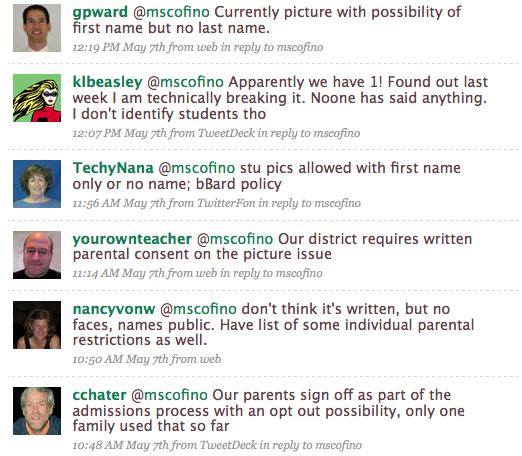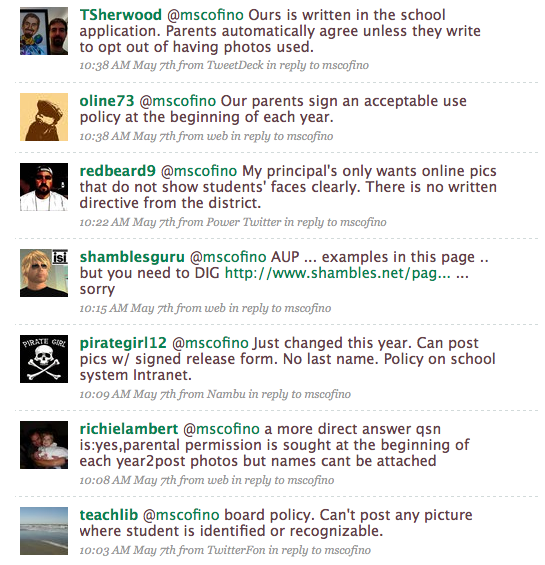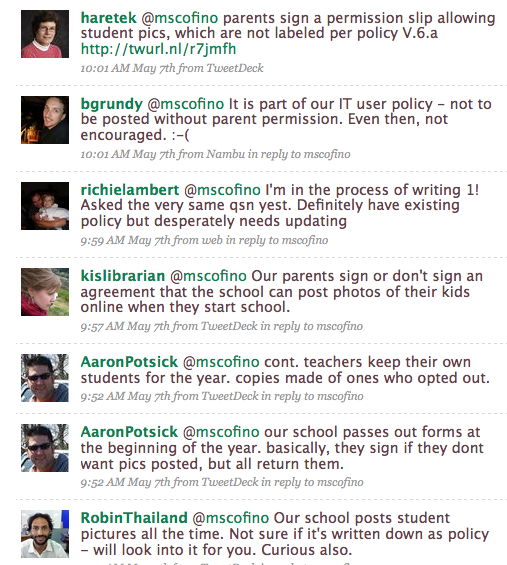Last week, our ISB21 Team had a long discussion about posting student pictures online. We’ve been extremely fortunate to have quite a few of our teachers embrace web 2.0 tools, especially our school-provided FlickrPro account.
We have teachers at almost every grade level regularly posting pictures for our parents. We know they love having a window into the classroom on a regular basis, but we haven’t determined specific guidelines for teachers about which pictures can be posted and which can’t.
So, during our meeting, I posed the following question on Twitter:
We had tons of responses back (thank you!):
It is great to see the different ways that so many schools deal with such a common issue (yet another reason to love Twitter). Now that we have some ideas, I think it’s worth discussing whether we need to standardize our expectations for posting student photos online.
Right now we have teachers on both ends of the spectrum: some posting pretty much every single thing that happens in their classroom to others never posting pictures that show student faces. I’m guessing that can be confusing for students when moving from one teacher to the next.
In order to model safe behavior for our students, and help build understanding of what is appropriate to share online, I think it’s important that we have a standard set for the whole school. This will also help us be clear in our expectations for teachers, and allow us to embed the guidelines in our AUP for all grade levels.
Another benefit of actually creating and implementing a set of guidelines would be starting a conversation about sharing images online with our colleagues. Personally, I’m pretty shocked at some of the pictures I see teachers (and other professionals) post on their Facebook (and other photo sharing) accounts. I think this will provide an opportunity not just to model appropriate behavior for the students, but also to help teachers build their own understanding of what should (and should not) be public information. In my opinion, starting that conversation is part of my job.
Whatever we decide, I hope it will be simple and easy for teachers to follow, but also not so restrictive that classroom and field-trip experiences can’t be shared publicly online. Here’s what I’m thinking right now:
These guidelines would become part of our AUP, and parents and students will sign off on the policy at the beginning of the school year after a lesson and discussion about the content of the AUP with students. Signatures would be acknowledging that the following guidelines are acceptable to both parents and students:
- Classroom and field-trip experiences may be published in public spaces online (for example our school Flickr account).
- When student images are posted, only first names or nicknames will be referenced.
- No identifying characteristics about students (beyond first names or nicknames) will be published in public spaces online.
- Work produced for education purposes may be published in public spaces in order to encourage global collaboration among students and teachers.
- Comments on student work will be moderated by the teacher to ensure only appropriate information is shared and received.
- Online safety and appropriate behavior will be emphasized whenever sharing student work online. Online spaces will be treated as classroom spaces.
What do you think? Does that cover the basics? Is this easy enough for teachers to follow without stress? Are we modeling appropriate and safe online behavior?












There is language in some USA statutes about “directory information”. You don’t want to confuse that with “identifying characteristics”.
What about links? If “Johnny” wins a big scholarship competition and the story is in CNN it probably has his last name (and parents name, etc…). A lot of school sites have RSS feeds which collect this type of information and automatically post it.
@Brandt,
Thanks for the tip. To be honest, I’m not so concerned about specific language at this point (or USA-based terminology since we’re an international school). Just wanted to get some feedback on the ideas.
Good thinking about the links. Again, I’m not sure this is as much of a problem in international schools (we don’t usually overlap with local papers in any way). But I’m still curious, how would you deal with that? Would the feeds have to be moderated by someone?
Thanks for collecting this information. I like your 6 numbered points. Easy to use for teachers posting photos.
You state that these will go into an AUP signed by students and parents, how are you currently handling a faculty AUP? Do you have one or is this part of the development? I am currently looking for good, easy to use examples of faculty AUP’s as we are trying to develop one for TAISM.
Have you thought about how your points translate to video posts or student blogging?
Thanks,
Links example: A student of mine is awarded Academic All-American. Do I link to the article/announcement?
Or…Board of Education minutes often have the full names of students who win awards. These minutes are almost always prominently displayed. (maybe not a consideration for you).
Anyway, I think it is really hard to follow these rules all the time. Is the expectation still that we hide student identity? Is it changing?
I believe that the classroom and field-trip experiences being published in public spaces online is a new way to get people to remember and solidify their experiences. This is a phenomenal idea.
Eric.
@Douglas,
Good questions! We do not have a faculty AUP at the moment. As far as I know, it’s not in development. We did have one at Munich International School when I was there, that might be a good place to start.
We do need to expand this to other forms of online interaction. I usually distribute a specific permission slip for when students are authors of the work, but it make so much more sense just to have it all in the AUP. This is currently a topic of discussion in our team meetings. If you’d like to see that permission slip, it’s posted here: Blogging is Elementary.
@Brandt,
Hmmm…. I wonder if this is an issue in international schools. I actually don’t know of any of these things happening in any of the international schools I’ve worked at. Might be more of a US-based challenge.
For me, the goal is to have consistency across classrooms and grade levels, to make these guidelines easy for all teachers to follow (and for all parents to understand). It’s not about hiding student identity, it’s about modeling appropriate and safe behavior online and ensuring that our actions reflect the attitudes and behaviors we are teaching our students.
@Eric205,
Thanks! Glad you find it useful!